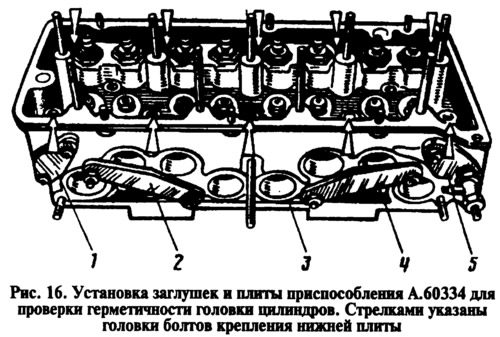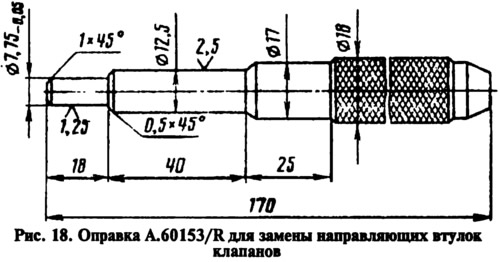Cylinder head
Before checking, install the cylinder head on a stand in the form of a metal or wooden frame, remove carbon deposits from the walls of the combustion chambers and from the surface of the exhaust channels with a conventional metal brush or a powered electric drill. Clean and inspect the inlet passages and oil supply passages to the valve actuating levers.
If there were cases of coolant getting into the oil, then check the tightness of the cylinder head, for which install plugs 1, 2, 4 on the head (pic. 16) with gaskets included in the set of tool A.60344, and bolt the bottom plate 3. Install the flange 5 with the water supply fitting and pump water inside the head at a pressure of 5 kgf/cm2. Within 2 minutes, no water leakage from the engine cylinder head should be observed.

You can check the cylinder head with compressed air, for which you install the parts included in the kit A.60334 on the cylinder head, lower it into a bath of water heated to 60-80°C, and let it warm up for 5 minutes. Submit compressed air inside the head at a pressure of 1.5-2 kgf / cm2. Within 1-1.5 minutes, no air should escape from the head. If cracks are found, replace the cylinder head.
Valve seats
Saddles (pic. 17) should not have on the working chamfers (valve contact area) pitting, corrosion and other damage. Minor damage on the surface of the working chamfers should be repaired by grinding with a grinder or by hand.

For grinding, place the cylinder head on a stand A.60353 or a metal or wooden frame and insert the stem A.94059 into the valve guide (there are two rods of different diameters: A.94059/1 for inlet valve guides and A.94059/2 for exhaust valve bushings). Remove soot and work hardening from the chamfers of the seats with A.94003 and A.94101 countersinks for intake valve seats and A.94031 and A.94092 countersinks for exhaust valve seats. Countersinks are put on the spindle A.94058 and centered by guide rods A.94059.
After cleaning the chamfers, put spring A.94059/5 on the rod A.94059, install on the spindle A.94069 the conical circle A.94078 for exhaust valve seats or the circle A.94100 for inlet valve seats, fix the spindle in a grinding machine and grind the seat, while removing as little metal as possible.
At the moment the wheel touches the seat, the machine must be turned off, otherwise vibration will occur and the chamfer will be incorrect.
After grinding, bring the width of the working chamfer to the values indicated in fig. 17. To finish the chamfer of the exhaust valve seat, put a countersink A.94031 on the spindle A.94058 (20°), then put the spindle with countersink on the guide rod A.94059 and countersink the seat to ∅ 30.5 mm. Then, with a countersink A.94092, bring the width of the chamfer to 1.6-1.7 mm (see fig. 17b).
To finish the chamfer of the inlet valve seat, put a countersink A.94003 on the spindle A.94058 and countersink the seat to ∅ 33 mm (see fig. 17a), then put a countersink A.94101 on the spindle and bring the width of the working chamfer to 1.9-2 mm.
If grinding fails to eliminate damage to the working facet of the seat, replace the cylinder head.
After grinding, check the tightness of the valves. To do this, install valves with springs in the cylinder head and pour kerosene into the inlet and outlet channels of the cylinder head. When holding for 3 minutes, no leakage of kerosene through the valves should be observed.
If valve leaks are found, regrind the valve face and seat on the cylinder head.
Valves
Before checking the valves, remove carbon deposits from them with a conventional brush or on a polishing machine with rotating brushes. Check if the rod is deformed (non-straightness of the rod is not more than 0.015 mm) and there are no cracks on the valve head. Replace damaged valve.
Check the condition of the valve face. In case of minor damage, grind, maintaining a chamfer angle of 45°30'±5' and making sure that the thickness of the cylindrical part of the valve disc after grinding is not less than 0.5 mm, and the exhaust valve does not have a layer of hard alloy deposited on the chamfer removed.
Valve guides
When checking the valve guides, check the clearance between them and the valve stems by measuring the diameter of the valve stem and the bore of the valve guide. The clearance value must match the data tab. 1. If the clearance is more than acceptable, replace the valve. If excessive clearance cannot be corrected by valve replacement alone, replace the guide bushing as well. For this operation use mandrel A.60153/R (pic. 18). Press in the guide bushings with the retaining ring on until the ring stops against the plane of the cylinder head. To replace the two guide bushings of the intake and exhaust valves of the 1st and 4th cylinders, unscrew the two studs securing the camshaft bearing housing, as they interfere with the installation of the mandrel.

After installing the guide bushings, expand the holes in them with reamers (A.90310/1 for inlet valve bushings and A.90310/2 for exhaust valve bushings). Then grind the valve seat and bring the width of the chamfer to the required dimensions, as indicated above.
Oil deflector caps for guide bushings
The caps are not allowed to peel off the rubber from the reinforcement, cracks and excessive wear of the working edge. When repairing the engine, it is recommended to always replace the oil seals with new ones. It is recommended to replace them with the cylinder head removed so as not to bend the valve stems. To press the caps, use the mandrel 41.7853.4016 (see fig. 15).
Valve levers
At the valve levers, check the condition of the working surfaces in contact with the valve stem, with the camshaft cam and with the spherical end of the adjusting bolt. If they have scuffs or risks, then replace the lever. If deformation or other damage is found on the bushing of the adjusting bolt or on the bolt itself, then also replace the damaged parts.
Valve springs and valve levers
Check the springs for elasticity and cracks. Elasticity is checked by the length of the spring in the free state (39.2 mm internal and 50 mm external) and under load: 13.9±0.7 and 28.1±1.4 kgf for internal (while the length should be respectively equal to 29.7 and 20 mm); 28.9±1.5 and 46±2.3 kgf for outdoor (while the length is respectively equal to 33.7 and 24 mm).
The data for checking the valve lever springs are as follows. The length of the spring in the free state is 35 mm, and under a load of 5.2–7.5 kgf it is 43 mm.
Cylinder head gasket
The surfaces of the gasket must be smooth, free of dents, cracks, swellings and kinks. Detachment of the lining material from the reinforcement is not allowed. There should be no cracks, burnouts and delaminations on the edging of the holes.
